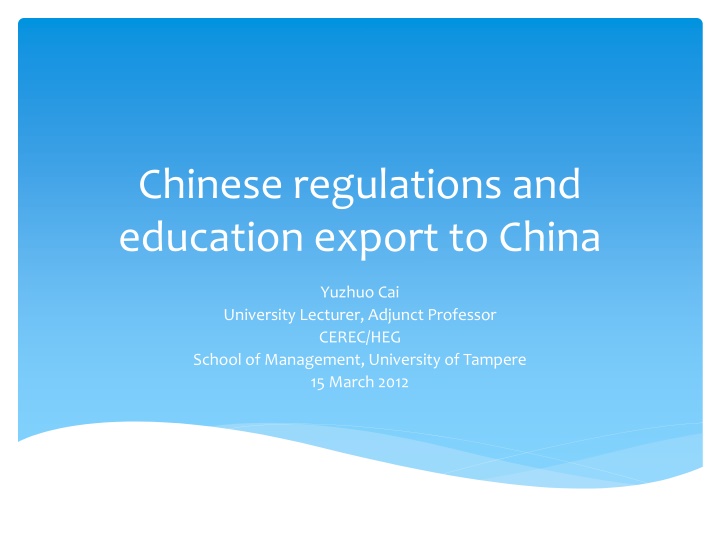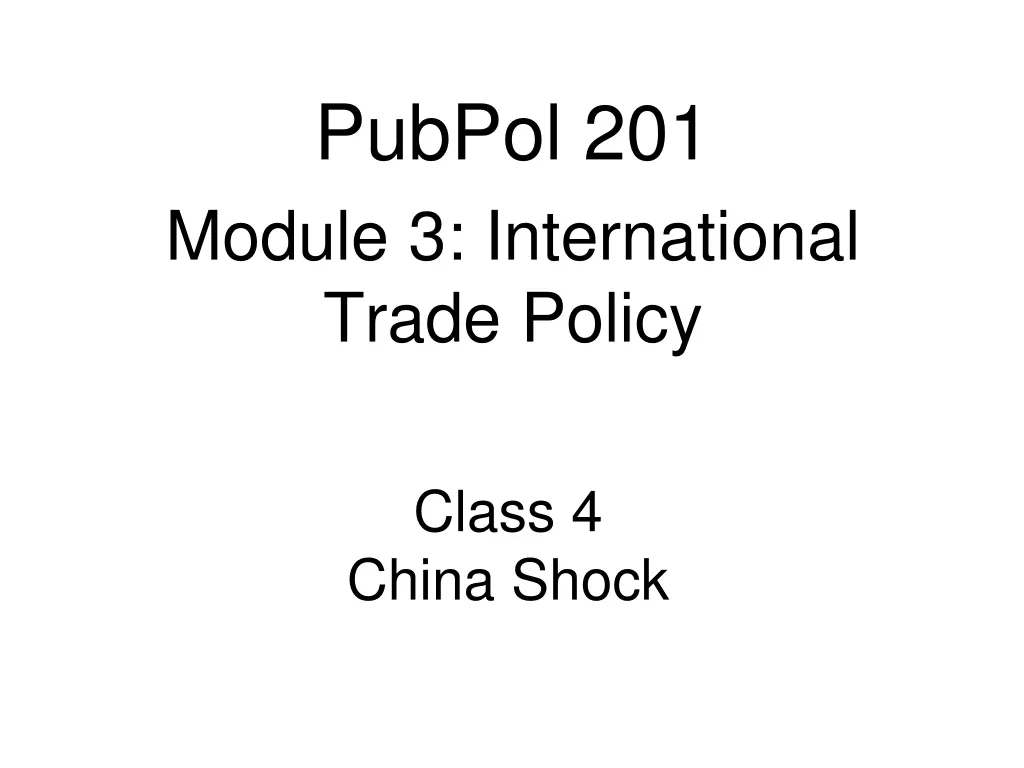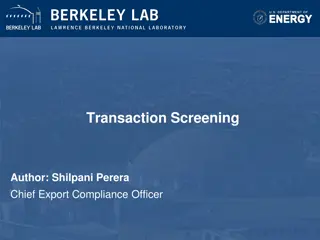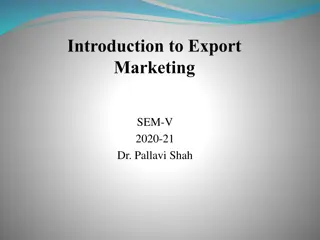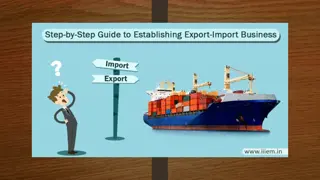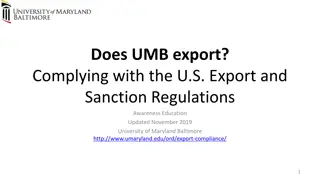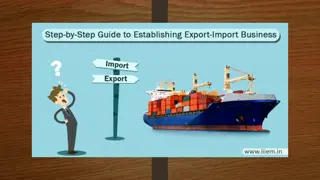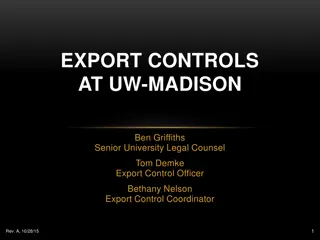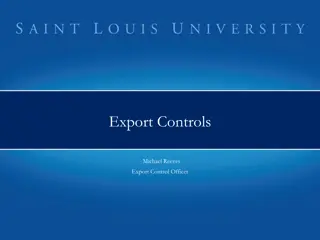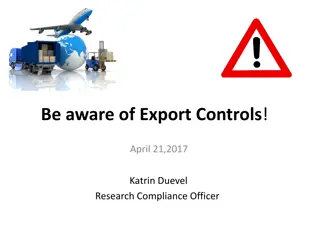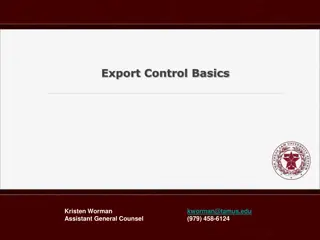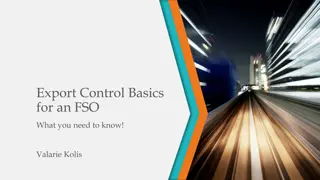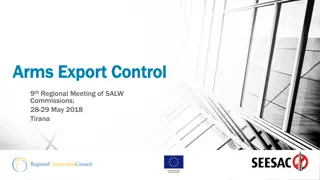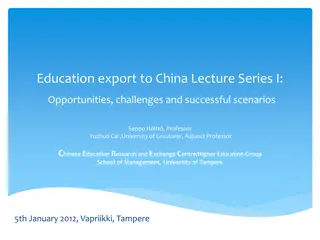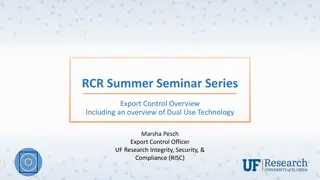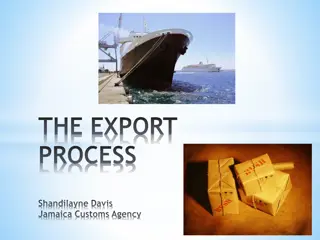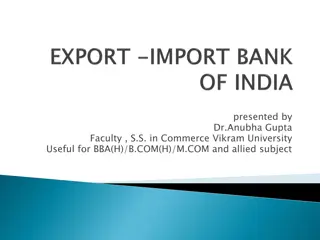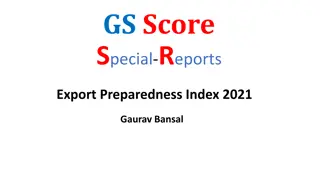Regulations and Education Export to China: Insights and Guidelines
Understand the Chinese regulations governing education export, including international agreements, domestic laws, and WTO commitments. Learn about key regulations, international organizations' impact, and China's stance on education services within the WTO framework.
Download Presentation

Please find below an Image/Link to download the presentation.
The content on the website is provided AS IS for your information and personal use only. It may not be sold, licensed, or shared on other websites without obtaining consent from the author.If you encounter any issues during the download, it is possible that the publisher has removed the file from their server.
You are allowed to download the files provided on this website for personal or commercial use, subject to the condition that they are used lawfully. All files are the property of their respective owners.
The content on the website is provided AS IS for your information and personal use only. It may not be sold, licensed, or shared on other websites without obtaining consent from the author.
E N D
Presentation Transcript
Chinese regulations and education export to China Yuzhuo Cai University Lecturer, Adjunct Professor CEREC/HEG School of Management, University of Tampere 15 March 2012
Targeting audience If you want to recruit Chinese students to study in your degree programmes in Finland (with a tuition fee) If you want to develop joint degree programmes with Chinese partners If you want to open a branch (or offshore campus) in China If you want to sell educational services to Chinese organisations and individual learners If you are just interested in the topic
Main regulations International regulations International organisations regulations and bilateral agreement on educational services China s commitment to WTO s General Agreement on Trade in Services (GATS) Domestic legislations Regulations on Sino-Foreign cooperatively running schools Regulations on academic degrees Accreditation of foreign degrees in China Intermediary agencies in student recruitment for foreign educational institutions
International organisation International rules have an impact on China s internal education activities UNESCO: the Code of Good Practice in the Provision of Transnational Education Respected in China but not legally binding for either the Chinese government or the Chinese educational institutions. Bilateral agreements on international cooperation and educational services WTO rules are more influential
WTO and education services China joined the WTO on 11 December 2001 Education is treated as a trade service Education services exclude: military, police, political and party school education Nine-year compulsory national education Education services include: Primary education services (excluding nine-year national compulsory education) Secondary education services (excluding nine-year national compulsory education) Higher education services Adult education services Other education services, including English language training
Commitment to GATS Four GATS modes: Cross-border supply Consumption abroad Commercial presence Presence of nature person China has limited access to the world s education markets according to China s commitment.
Mode 1: Cross-border supply Cross-border supply mainly refers to the provision of distance educational courses and services. However, China has made no commitment to cross-border supply in terms of either market access or national treatment. This does not necessarily mean that foreign educational institutions could not provide education services through distant education in China. Rather, China could independently decide how to create this market according to its own standards without being bounded by the GATS.
Mode 2: Consumption abroad Consumption abroad mainly refers to citizens of one country studying in another country. China has imposed no limitations either on market access or national treatment, meaning that the Chinese government has not taken any measures to restrict Chinese citizens from studying abroad, and from receiving citizens of the other WTO member countries to study in China.
Mode 3: Commercial presence Commercial presence refers primarily to the educational institutions from one country in another country to set up schools and other educational institutions that are engaged in education and related services. According to China s commitment, foreign education institutions are not allowed to independently set up branches and other organisations. Foreign education institutions may enter China, but must partner with Chinese institutions to establish joint schools, whereas foreign majority ownership is permitted.
Mode 4: Presence of natural persons Presence of natural persons refers primarily to the citizens of one country in another country who are engaged in professional teaching and training. China has set a limit on market access with respect to the movement of people: qualified foreign individuals may enter China to provide education services when invited or employed by Chinese education institutions.
Regulations on Chinese-Foreign cooperation in running schools (CFCRS) 1995: Interim Provisions on Chinese-Foreign Cooperation in Running Schools, State Council 2003: Regulations on Chinese-Foreign Cooperation in Running Schools, State Council Definition of Chinese-Foreign Cooperation in Running Schools: The activities of the cooperation between foreign educational institutions and Chinese educational institutions in establishing educational institutions within the territory of China to provide education service mainly to Chinese citizens .
Main stipulations (in both 1995 Interim and 2003 Regulations) foreign institutions must partner with Chinese institutions; partnerships must not seek profit as their objective; no less than half of the institution governing body members must be Chinese citizens; the post of president or the equivalent must be a Chinese citizen residing in China; the basic language of instruction should be Chinese; tuition fees may not be raised without approval.
Changes in the 2003 Regulations extending governmental encouragement from vocational to higher education, promoting Chinese universities to cooperate with renowned overseas HEIs in launching new academic programmes to improve the quality of teaching and learning and to import excellent overseas educational resources to local institutions, relaxing the restrictions on profit-making.
2004: the Implementation Measures for the Regulation on Chinese-Foreign Cooperation in Running Schools 2004: the Implementation Measures for the Regulation on Chinese-Foreign Cooperation in Running Schools, MOE not only joint venture schools but also joint programmes A Chinese-foreign jointly run school is entitled to the support and encouraging measures granted to privately run schools by the State in line with the provisions of the Law on Promotion of Privately-run Schools a jointly run school shall not engage in profit-making operational activities but that reasonable economic returns are allowed.
Reasonable returns At the end of each fiscal year, a Chinese-foreign jointly run school, whose vested parties do not require reasonable returns, shall withdraw a sum of money from the increased amount of its annual net assets, and the Chinese-foreign jointly run school whose vested parties have requested reasonable returns shall withdraw a sum of money from the annual net gains, no less than 25% of the increased amount of annual net assets or of annual net gains, to serve as development fund used for the construction and maintenance of the Chinese-foreign jointly run school and the purchase and renovation of teaching equipment. (Article 29)
MOEs administrative imperatives 2006: Opinions on Some Issues Concerning Chinese- Foreign Co-operation in Running Schools 2007: The Notification on further standardising the system of Chinese-Foreign Co-operation in Running Schools
Main messages of the 2006,2007 documents The Chinese government is not satisfied with the current situation on Chinese-foreign cooperation in running schools The nature of Chinese-foreign school operation as a public service must be preserved. The Chinese educational institution in the cooperation shall play a dominant role in carrying out national educational policies; High-quality foreign educational resources are encouraged, while the quality control needs to be strengthened; The standards of the tuition fees of the Chinese and foreign cooperative programmes are to be regulated.
Stagnancy 2006-2010 Since 2006, the Ministry has taken a strict line on approving new joint school applications. In practice, few applications have been acceded to. 2009, evaluation of existing joint education institutions and programmes. Close down of unqualified joint institutions and programmes
New area of Chinese-foreign cooperation in running schools 2010: The Outline of National Plan for Medium and Long- term Education Reform and Development (2010-2020) The Outline has signalled that the Sino-foreign Cooperation in Running Schools will be encouraged and expanded. The government expects that through importing international educational ideas, curricula and teaching staff, more talent with international skills and perspectives will be cultivated in China to meet the needs of economic development. However, the government will raise the threshold, meaning only those prestigious and high-quality foreign partners can be granted permission to China.
How to operate in practice Find a local educational institution as co-operator and apply for governmental approval in China. There are three ways to cooperate with Chinese partners in establishing the CFCRS: a cooperatively run independent institute (a joint venture), a school or college affiliated to a Chinese host university, a joint programme.
Examination and approval Education programmes Approval Authorities BA degree and above MOE Sub-degree (three-year higher education) Local educational authorities (provincial, municipal) Secondary education Local educational authorities (provincial, municipal) Vocational education Local educational authorities (provincial, municipal)
Legal challenges in CFCRS 1 No-profit defined by the Chinese regulations vs. education as a trade service defined by WTO Chinese-foreign cooperation in running schools is an undertaking beneficial to public interests and forms a component of China s educational cause (Article 3, 2003 Regulations). Chinese language vs. foreign language (Unclear definition of basic teaching language ) A Chinese-foreign cooperatively-run school may, if necessary, use foreign languages in teaching, but shall use the standard Chinese language and standard Chinese characters as the basic teaching language (Article 31, 2003 Regulations).
Legal challenges 2 Ambiguous intangible assets evaluation A Chinese or foreign co-operator in running a school may contribute with funds, in kind or in forms of land-use right, intellectual property rights or other assets to establish the school. Contribution of intellectual property rights by a Chinese or foreign co- operator in running a school shall not exceed one-third of its total contribution. However, for a foreign educational institution that comes to China for cooperation in running a school at the invitation of the education administrative department or the labour administrative department of the State Council or at the invitation of the people s government of a province, an autonomous region or a municipality directly under the Central Government, its contribution in the form of intellectual property rights may exceed one-third of its total contribution. (Article 10, 2003 Regulations)
Legal challenges 3 Lack of matching legal provisions and policies The legal rights and interests of Chinese and foreign co- operators in running schools and of Chinese-foreign cooperatively-run schools shall be protected by the laws of China. Chinese-foreign cooperatively-run schools shall enjoy preferential policies made by the State and enjoy autonomy when conducting educational activities in accordance with law. (Article 4, 2003 Regulations)
Legal challenges 4 When a Finnish HEI establishes a joint venture school in China by being a shareholder of the organisation, is it legal or not according to Finnish law that the joint school charges local students tuition fees?
Accreditation of foreign degrees All foreign degrees (incl. the degrees offered in CFCRS) need to be accredited by the Chinese authorities. Chinese Service Centre for Scholar Exchange (CSCSE), MOE CSCSE does not accredit the degrees acquired through corresponding education, long distance education and internet education.
Intermediary Agents recruiting Chinese students for foreign institutions The role of intermediary agent is often overlooked or misunderstood. The agents charge (high) service fees when helping Chinese students to study in Finland Conflict to Finnish ideologies? A partner in education export?
What is the Intermediary Agent for Self-sponsored Study Abroad Many intermediary agents and consulting companies established in the 1990s as a market response to the increase of self-sponsored students to study abroad In 1999, 700-800 intermediary agents in Beijing only The operation was not regulated and some agents conducted illegal operations. 1999: The Regulations on the Intermediary Agents for Self- sponsored Study Abroad by Ministry of Education, Ministry of Public Security and State Administration of Industry and Commerce
Regulations on the Intermediary agents for self-sponsored study abroad An intermediary agent needs a permission from the MOE 419 registered agents in China by March 2012 http://www.jsj.edu.cn/index.php/default/intermediary/index Business scope: Information and legal consulting, Proxy to make admission application Support for visa application Training before traveling abroad, etc. Targeting clients: those Chinese citizens who have completed the secondary education
Implications for Finnish educational providers The local partner will help you in recruiting students in the Chinese student market. You need to know whether the partner is a legal intermediary agent. Not without problem, but monitored by the MOE. Don t have business transaction before signing a contract!
Training Chinese officials and professionals Many Chinese officials and professionals are sent to advanced and developed countries to take training courses or degree studies ranging in length from a few weeks to a year and over. The training are organised by either Chinese central or local governmental organizations, but their plans must be submitted to the State Administration of Foreign Experts Affairs (SAFEA) for approval. The SAFEA is the administrative department of the Chinese government in charge of the national introduction of foreign intellectual resources from abroad and also in charge of sending Chinese technical and managerial professionals from government departments and enterprises for overseas training.
What need to know? The organisation of training is highly regulated. What kinds of programmes Where to go How much is the budget How to make the contract No open source documents from which you can find the regulations.
Chinese laws on education Education Law, 1995 Vocational Education Law, 1996 Higher Education Law, 1998 Law for Promoting Private Education, 2002 Regulations on Academic Degrees, 1980, amendment 2004
General laws Contract Law applicable to contracts signed between foreign educational institutions and Chinese educational service institutions. Civil Law applicable to the civil relationships between students and educational service providers. Administration Law applicable to the legal relationships between educational service providers and government authorities Other domestic laws Tax Law, Intellectual Property Rights Law
Legislation vs. Government mandates Despite of the improvement of legal system on education Government mandates are commonly used in education administration
Finnish legislation Finnish HEIs are allowed to charge tuition fees for degree education from students coming outside the EU or EEA under two conditions: The 2007 Amendments to both the Universities Act (1997/645) and the Polytechnics Act (2003/351) allowed Finnish HEIs to charge fees for their degree education programmes when the fees are paid by a third organisation rather than individual students, called the made to order (in Finnish tilauskoulutus) model. According to the new Universities Act (558/2009) and the additional Amendments to the Polytechnics Act (2003/351) both effective from the beginning of 2010, Finnish HEIs are able to charge tuition fees on a five-year trial basis for separate Master s programmes from foreign students, provided that the arrangements include a scholarship scheme.
Location of Finnish Providers China Finland Model 3 and Model 4 CFCRS (one campus model) Individual Finnish experts teaching or provider educational services in China How can Finnish institutions collect fees from students or clients? CFCRS (two campus model) Students will study on both the local campus in China and the campus at the Finnish institution. Model 1 Distance education China Location of Chinese Students Model 2 Students study in Finland Pilot MA programme Contracted degree education Professional degree education Non-degree/short term training Finland
Further readings Cai, Y. (2011). Cross-border higher education in China and its implications for Finland. In Y. Cai & J. Kivist (Eds.), Higher education reforms in Finland and China: Experiences and challenges in post-massification era (pp. 245-260). Tampere: Tampere University Press. Cai, Y., H ltt , S., & Lindholm, N. (2012) Developing offshore education in China: A perspective from Finland. CEREC Working Paper Series No.1. Tampere, Finland: Chinese Education Research and Exchange Centre, University of Tampere. http://www.uta.fi/jkk/cerec/publications/workpaper/CEREC%20Working%20P aper%201.pdf Cai, Y., H ltt , S., & Kivist , J. (2012). Finnish higher education institutions as exporters of education--are they ready? In S. Ahola & D. Hoffman (Eds.), Higher education research in Finland: Emerging structures and contemporary issues (pp. 215-233). Jyv skyl : Finnish Institute for Higher Educational Research, University of Jyv skyl .
